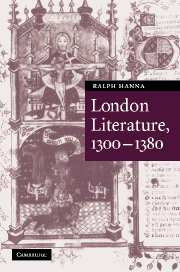Book contents
- Frontmatter
- Contents
- List of abbreviations
- In Thrall
- 1 English vernacular culture in London before 1380: the evidence
- 2 The ‘Old’ Law
- 3 Reading romance in London: The Auchinleck Manuscript and Laud misc. 622
- 4 Pepys 2498: Anglo-Norman audiences and London biblical texts
- 5 Anglo-Norman's imagined end
- 6 ‘Ledeþ hire to Londoun þere lawe is yshewed’: Piers Plowman B, London, 1377
- The end of early London literature
- Bibliography
- Index of manuscripts cited
- General index
- Cambridge Studies in Medieval Literature
3 - Reading romance in London: The Auchinleck Manuscript and Laud misc. 622
Published online by Cambridge University Press: 22 September 2009
- Frontmatter
- Contents
- List of abbreviations
- In Thrall
- 1 English vernacular culture in London before 1380: the evidence
- 2 The ‘Old’ Law
- 3 Reading romance in London: The Auchinleck Manuscript and Laud misc. 622
- 4 Pepys 2498: Anglo-Norman audiences and London biblical texts
- 5 Anglo-Norman's imagined end
- 6 ‘Ledeþ hire to Londoun þere lawe is yshewed’: Piers Plowman B, London, 1377
- The end of early London literature
- Bibliography
- Index of manuscripts cited
- General index
- Cambridge Studies in Medieval Literature
Summary
Every scholar who has seriously examined the Auchinleck MS has agreed that it is composed of twelve booklets (for these, see facsimile ix). Although certainly preserved in an intended order, fixed by the consecutively numbered texts, and imposed by scribe 1 at the end of the work, these pieces are almost certainly not preserved in anything like the order of their production (see pp. 75–9). That being said, it is possible to see in the book a somewhat more coherent structure, imposed by scribe 1, than merely the constituent production pieces.
Rather broadly, the book can be divided into three sections (cf. Turville-Petre 1996, 112–13, within an exciting extended discussion 108–41). At the head, Booklet 1 and the first text of Booklet 2 (item 10, the ‘Speculum Gy de Warwick’) stand apart. These are certainly separate from what follows (indeed, within the manuscript, the ‘Speculum’ is marked off by a change of scribal hand), and more unremittingly religious in emphasis than anything that will ensue. Moreover, the works are, in the context of this manuscript, unusually brief, and they share a general origin as being imports, not local London work. Analogues to these poems appear almost exclusively in a series of important thirteenth and early fourteenth-century miscellanies from the Worcester–Hereford area: Bodleian Library, MS Digby 86; Cambridge, Trinity College, MS B.14.39 (323); and British Library, MS Harley 2253, or their later Western derivatives (e.g. the Vernon MS).
- Type
- Chapter
- Information
- London Literature, 1300–1380 , pp. 104 - 147Publisher: Cambridge University PressPrint publication year: 2005

